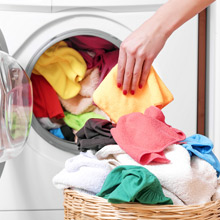Laundry
Energy used to wash and dry clothing can contribute significantly to your home or apartment’s energy bill. The tips below can help you “lighten the load” your laundry adds to your electric bill.
Qualifying Clothes Washers and Dryers may be eligible for instant discounts at participating retailers.
Clothes Washers

- If you wash your clothes in warm or hot water, consider using cold water instead. Unless you are trying to remove grease stains, cold water will get your wash just as clean for a lot less money than hot water.
- Consider the efficiency of the water heater supplying hot water for your washer. Heat Pump Water Heaters can use 30 – 50% less energy than a standard electric hot water tank and can cost half as much to operate. If you have an electric hot water heater, you can receive a rebate to switch to a HPWH.
- ENERGY STAR MOST EFFICIENT-certified clothes washer models will
- cut water usage by over 30%
- cut energy consumption by 60% (if you wash with hot water; you could save more if you wash with cold water)
- generally need less detergent,
- and may be gentler on clothes.
IMPORTANT: Burlington Electric Department rebates on clothes washers are only available on ENERGY STAR MOST EFFICIENT-designated appliances. Not all ENERGY STAR-certified appliances have this special designation.
Ventless Clothes Dryers & Combination Washer-Dryers
IMPORTANT: Burlington Electric Department rebates on ventless heat pump clothes dryers are only available on ENERGY STAR MOST EFFICIENT-designated appliances. Not all ENERGY STAR-certified appliances have this special designation.
Puchasing Tips
- Standing drying racks, or outdoor clotheslines in temperate weather are the least expensive drying methods. If it is hot and sunny, a clothesline can dry your clothes faster than a dryer. Using a passive drying method could save you $10 – $20 per month.
- When using a dryer, select low-heat settings like ‘Delicates’ to minimize energy and costs associated with clothes drying.
- When shopping for a new clothes dryer, consider a ventless dryer (either condensing or heat pump). Did you know that a standard electric dryer can exhaust the entire heated (or cooled) volume of air of the entire house in a single drying cycle? Ventless dryers perform comparably to standard electric clothes dryers, and do not require an exhaust vent to the outside. This results in a tremendous energy saving advantage, and can improve the aesthetics of your home by not requiring a vent termination through the siding or exterior finish. While ventless dryers do not require an exhaust vent to the outside, they do require a drain connection. A clothes washer drain box is an acceptable approach.
- ENERGY STAR-certified dryers use 20% less energy than standard models. Those designated as Most Efficient deliver increased energy savings.
Safety Tips
- Cleaning your dryer’s exhaust vent is a quick and easy way to save a little energy while practicing good fire safety. A clogged dryer vent is a significant safety hazard. At least once a year, you should disconnect the vent pipe and clean out the lint. While this may only save a small amount on your utility bill, it could prevent a house fire.
- Plastic dryer vents are also a potential fire hazard. Buy a rigid aluminum or galvanized steel pipe vent if you are if you are replacing a dryer or the dryer vent. The material is long-lasting, much safer, and the smooth pipe walls allow for more efficient airflow and fewer surfaces on which to catch drier lint.


 Clothes Washer
Clothes Washer Clothes Dryer
Clothes Dryer Combination Clothes Washer & Dryer
Combination Clothes Washer & Dryer